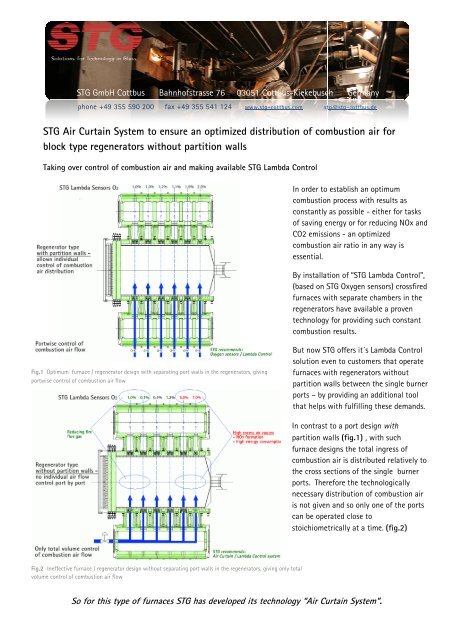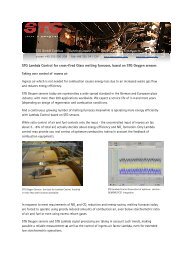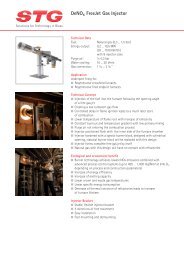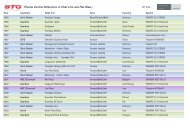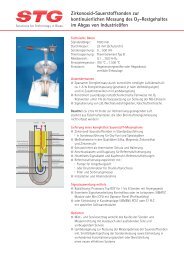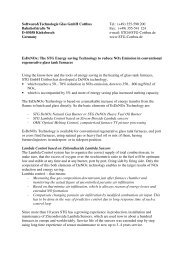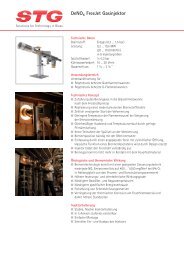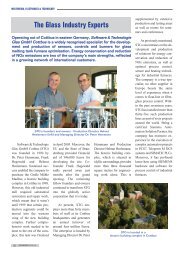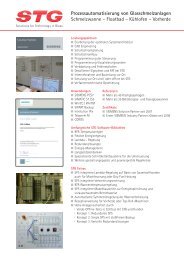STG Air Curtain System, to ensure an optimized ... - STG Cottbus
STG Air Curtain System, to ensure an optimized ... - STG Cottbus
STG Air Curtain System, to ensure an optimized ... - STG Cottbus
Create successful ePaper yourself
Turn your PDF publications into a flip-book with our unique Google optimized e-Paper software.
<strong>STG</strong> Gm bH <strong>Cottbus</strong> Bahnhofstrasse 76 03051 <strong>Cottbus</strong>-Kiekebusch Kiekebusch Germ <strong>an</strong>y<br />
phone +49 355 590 200<br />
<strong>STG</strong> <strong>Air</strong> <strong>Curtain</strong> <strong>System</strong> <strong>to</strong> <strong>ensure</strong> <strong>an</strong> optim ized distribution of com bustion air for<br />
block type regenera<strong>to</strong>rs w ithout partition w alls<br />
Taking over control of com bustion air <strong>an</strong>d m aking available <strong>STG</strong> Lam bda Control<br />
Fig.1 Optim um furnace / regenera<strong>to</strong>r design w ith separating port w alls in the regenera<strong>to</strong>rs, giving<br />
portw ise control of com bustion air flow<br />
fax +49 355 541 124 w w w .stg-cottbus.com stg@ stg stg-cottbus.de<br />
Fig.2 Ineffective furnace / regenera<strong>to</strong>r design w ithout separating port w alls in the regenera<strong>to</strong>rs, giving only <strong>to</strong>tal<br />
volum e control of com bustion air flow<br />
In order <strong>to</strong> establish <strong>an</strong> optim um<br />
com bustion process w ith results as<br />
const<strong>an</strong>tly nst<strong>an</strong>tly as possible - either for tasks<br />
of saving energy or for reducing N Ox <strong>an</strong>d<br />
CO2 em issions - <strong>an</strong> optim ized<br />
com bustion air ratio in <strong>an</strong>y w ay is<br />
essential.<br />
By installation of “<strong>STG</strong> Lam bda Control”,<br />
(based based on <strong>STG</strong> Oxygen sensors sensors) crossfired<br />
furnaces w ith separate cham bers in the<br />
regenera<strong>to</strong>rs have available a proven<br />
technology for providing such const<strong>an</strong>t<br />
comm bustion results results.<br />
But now <strong>STG</strong> offers it´s Lam bda Control<br />
solution even <strong>to</strong> cus<strong>to</strong>m ers that operate<br />
furnaces w ith regenera<strong>to</strong>rs w ithout<br />
partition w alls betw een the single burner<br />
ports – by providing <strong>an</strong> additional <strong>to</strong>ol<br />
that helps w ith fulfilling these dem <strong>an</strong>ds.<br />
In contrast <strong>to</strong> a port design w ith<br />
partition w alls (fig.1) , w ith such<br />
furnace designs the <strong>to</strong>tal ingress of<br />
com bustion air is distributed relatively <strong>to</strong><br />
the cross sections of the single burner<br />
ports. Therefore the technologically<br />
necessary distribution of com bustion air<br />
is not given <strong>an</strong>d so only one of the ports<br />
c<strong>an</strong> be operated close <strong>to</strong><br />
s<strong>to</strong>ichiom etrically at a tim e. (fig.2)<br />
So for this type of furnace furnaces <strong>STG</strong> <strong>STG</strong> has has developed developed its its technology technology “<strong>Air</strong> “<strong>Air</strong> <strong>Curtain</strong> <strong>Curtain</strong> <strong>System</strong> <strong>System</strong> ”. ”.
Basics of <strong>STG</strong> <strong>Air</strong> <strong>Curtain</strong> <strong>System</strong><br />
Com pressed air l<strong>an</strong>ces w ith active w ater cooling, that w e refer <strong>to</strong> as “air baffles”, have <strong>to</strong> be installed in<strong>to</strong> the<br />
typical excessive-air-ports (e.g. ports 5 <strong>an</strong>d 6). Em ploying nozzles that are individually aligned w ith the ports<br />
geom etry, a barrier of com pressed air is created, that faces the com bustion air flow . (fig. 4)<br />
Fig.3 Com pressed air baffle, installed in<br />
the port bot<strong>to</strong>m<br />
Fig.5 Installation in the port bot<strong>to</strong>m<br />
Fig.6 Starting situation: port 6 btw . 5… 6% <strong>an</strong>d port 5 btw . 2,5… 4% O 2<br />
Fig.4 W orking principle of com pressed air baffle: deflecting of excess com bustion air <strong>to</strong> air deficient ports<br />
This Technology allow s us <strong>to</strong> regulate the am ount of incom ing air at every<br />
single burner port individually <strong>an</strong>d dynam ically through adjustable blocking by<br />
the air baffles. Excessive air is deflected <strong>an</strong>d forced through the regenera<strong>to</strong>r<br />
head <strong>to</strong>w ards the neighboring air deficient ports. As soon as <strong>an</strong> harm onized O 2<br />
profile is established w e are free <strong>to</strong> reduce <strong>to</strong>tal air <strong>to</strong> signific<strong>an</strong>tly optim ize<br />
the O 2 profile. This allow s us <strong>to</strong> operate the m ajority of the ports nears<strong>to</strong>ichiom<br />
etrically.<br />
See figures 6 <strong>an</strong>d 7 <strong>to</strong> com pare O 2 profile before <strong>an</strong>d after installation of the<br />
<strong>Air</strong> <strong>Curtain</strong> <strong>System</strong> (<strong>to</strong>gether w ith <strong>STG</strong> Oxygen m easurem ent).<br />
Fig.7 After Lam bda Control <strong>an</strong>d <strong>Air</strong> <strong>Curtain</strong> installation: harm onized O2 profile<br />
w ith port 6 btw . 1,8… 2,5% <strong>an</strong>d port 5 btw . 1,2… 2% O 2
So w hat does cus<strong>to</strong>m er need <strong>to</strong> install <strong>STG</strong> <strong>Air</strong> <strong>Curtain</strong>?:<br />
Precondition: <strong>STG</strong> Oxygen sensors at all ports of the furnace, left <strong>an</strong>d right<br />
Com pressed <strong>Air</strong> baffles <strong>to</strong> control the com bustion air distribution (each 1 baffle per port <strong>an</strong>d firing<br />
side) – typical is a 3… 5 ports air blocking system<br />
Preparative therefore vertical drillings have <strong>to</strong> be m ade in port bot<strong>to</strong>m , diam eter 50… 60m m<br />
Supply of com pressed air w ith 4… 5 Bar (e.g. 30N m 3<br />
/h of com pressed air are needed <strong>to</strong> deflect <strong>an</strong><br />
am ount of approx. 300N m 3<br />
/h preheated air)<br />
N on-active side requires continuous sm all flow of com pressed air, as purge air (5… 10N m 3<br />
/h)<br />
Supply of continuous w ater cooling, closed loop, best available quality (as for electric booster holders,<br />
Top Roll m achines, Stirrer cooling… ) w ith 2.5 Bar, approx. 10… 25l/m in (0.6… 1.5N m 3<br />
/h) per baffle <strong>to</strong><br />
install<br />
Control skid for w orking air required (st<strong>an</strong>dard scope of <strong>STG</strong>)<br />
Control skid for w ater cooling required (st<strong>an</strong>dard scope of <strong>STG</strong>)<br />
For au<strong>to</strong>m atic control / <strong>STG</strong> Lam bda Control: PLC <strong>an</strong>d Touch P<strong>an</strong>el, alternatively signal processing<br />
directly in DCS (st<strong>an</strong>dard scope of <strong>STG</strong>)<br />
Fig.8 Com plete <strong>STG</strong> Lam bda Control <strong>System</strong> w ith Oxygen sensors, <strong>Air</strong> <strong>Curtain</strong> system <strong>an</strong>d au<strong>to</strong>m atic control w ith SIM ATIC CPU<br />
<strong>STG</strong> <strong>Air</strong> <strong>Curtain</strong> , <strong>STG</strong> Oxygen sensors , <strong>STG</strong> PCS7 Furnace Control system s <strong>an</strong>d <strong>STG</strong> Lam bda Control as essential<br />
elem ents of <strong>STG</strong> com plex DeN Ox technology are w ell coordinated <strong>an</strong>d harm onized w ith each other. Therefore it<br />
is recom m ended <strong>to</strong> use <strong>Air</strong> <strong>Curtain</strong> in a com bination w ith PCS7 <strong>an</strong>d Oxygen sensors by <strong>STG</strong>, but m inim um is a<br />
purchase of a full <strong>STG</strong> Oxygen m easurem ent at the sam e tim e.<br />
Your Contact:<br />
Dipl.-Ing. Andreas Birle , Head of <strong>STG</strong> Burner departm ent<br />
m ail <strong>to</strong>: <strong>an</strong>dreas.birle@ stg-cottbus.de<br />
Phone: +49 355 590 20 18


